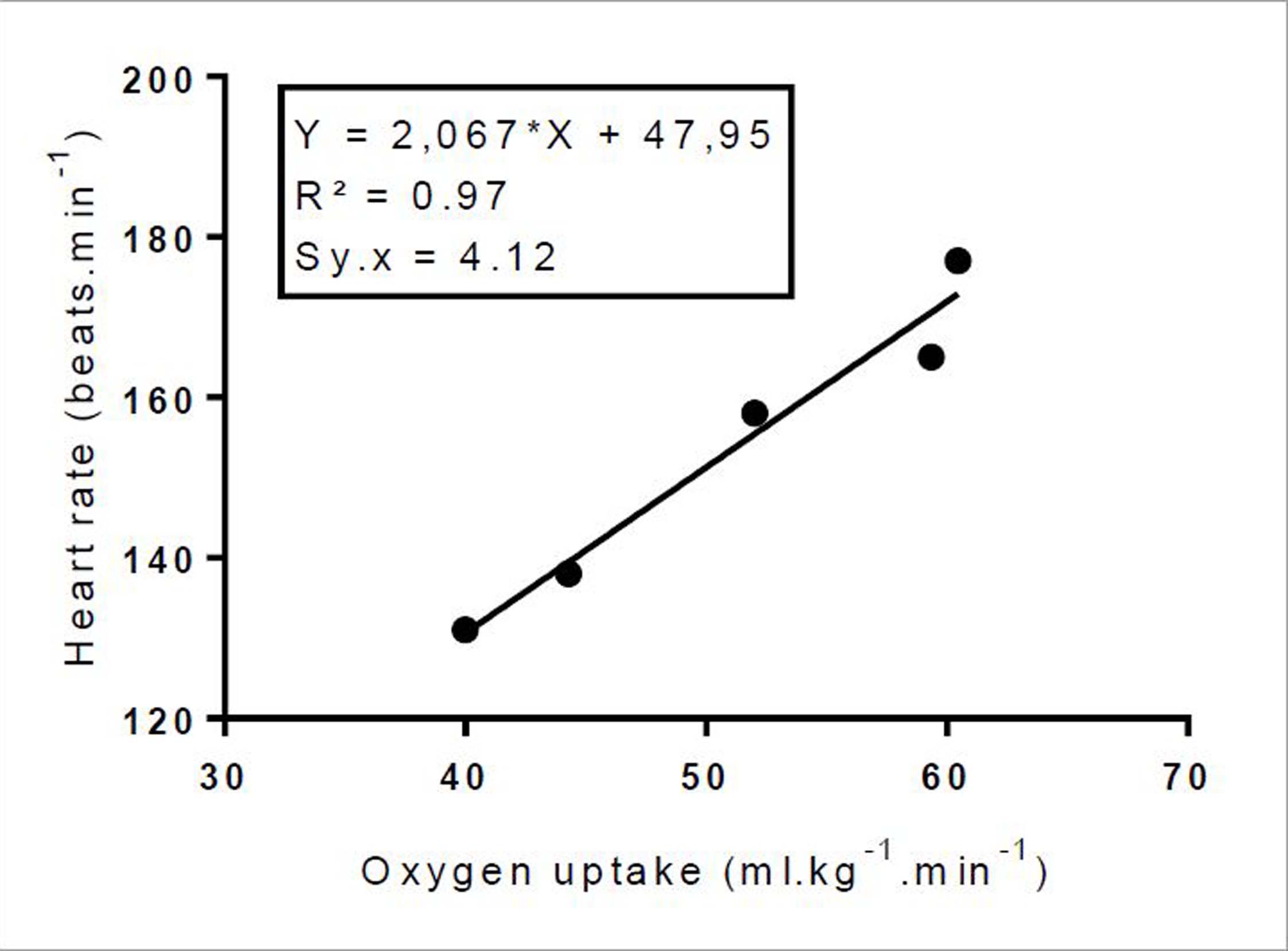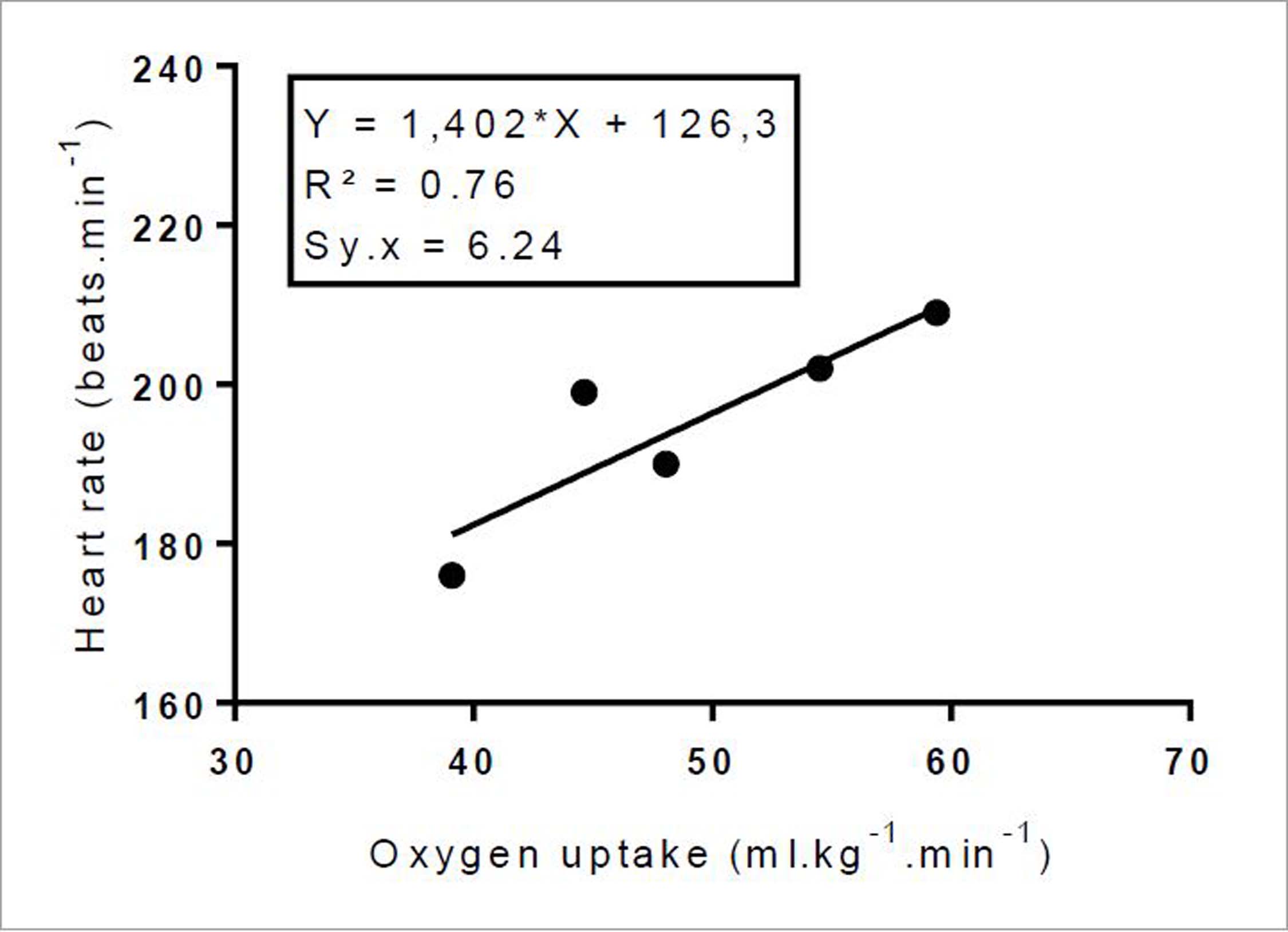INTRODUCTION
Indirect calorimetry based on oxygen uptake (VO2) is the gold-standard procedure to assess the energy demand during physical activities (McClave et al., 2016). Unfortunately, very few professionals that work in sports do have easy access to gas analysers. This is a perfect justification for several attempts to validate other measurements to estimate sports’ energy demand (Leenders, Sherman, & Nagaraja, 2006; Fudge et al., 2007). With technological advancement, wearable equipment has made heart rate (HR) measurement easy and reliable. HR monitors are just useful tools to prescribe exercise intensity and monitor training adaptations in exercise prescription (Franco, Oliveira, Neves, & Santos, 2004).
The VO2 - HR relationship is vastly used to assess the energy demand during locomotion in animals (Brosh, 2007; Halsey et al., 2008), and it is equally well investigated in humans (Garet et al., 2005). The VO2 - HR relationship is often used in the medical field (Mezzani et al., 2007) and to assess children's physical activity (Iannotti, Claytor, Horn, & Chen, 2004), but less in the sports training field (Vella & Robergs, 2005). The potential of HR to be used as a valid exercise intensity indicator fell back on establishing the individual relationship between VO2 and HR. The precision of this technique depends on the robustness of the regression line (Reis, den Tillaar, & Marques, 2011).
The precision of the VO2 - exercise intensity regression is well described and accepted during treadmill running (Reis et al., 2007) or running on a track (Reis, Duarte, Espírito-Santo, & Russell, 2004). However, the literature presents less evidence to confirm the robustness of regression models between VO2 and HR during running exercises (Hilloskorpi et al., 1999). It is our opinion that there is a lack of studies addressing the VO2 – HR regression issue, and little attention has been given to the standard error of these regressions. Indeed, using correlation coefficients to interpret the regression is quite limited if not inadvisable.
Reis et al. (2011) have studied the robustness of linear regression in the relationships between VO2 and running velocity, HR and running velocity, and HR and VO2 in highly trained long-distance roadrunners. Strong relationships between HR, running velocity and VO2 were found in this study, which would allow the use of HR as an accurate indicator of energy demand and of running speed in this kind of athletes. However, that study was limited to endurance-trained runners.
Regarding power athletes within the same sports, i.e. sprinters, it is likely that due to the different metabolic profile of their performances, the HR and VO2 responses vary when compared with long-distance athletes. Thus, the robustness of the linear regression of the HR - VO2 relation in these individuals would tend to be less accurate. The goal of the present study was to compare the relationship between HR and VO2 between endurance and long-sprint-trained runners.
METHOD
The present work is characterised as cross-sectional descriptive, where the HR will be used as a dependent variable and VO2 as the independent variable.
Participants
Twenty male subjects volunteered for this study after medical approval. The participants composed of two equal groups of 10 athletes each:
Group A: national-level endurance track or road runners;
Group B: national-level long-sprint runners (400 m).
The mean age, years of systematic training, height and body mass of Group A subjects were, respectively: 31.5± 4.7 years, 15.2± 6.2 years, 1.74± 0.04 m and 61.8± 5.2 kg. In Group B, the mean age, years of systematic training, height and body mass were, respectively: 25.7± 4.5 years, 12.5± 4.3 years, 1.77± 0.08 m and 71.2± 5.8 kg. The subjects gave their written informed consent to participate in the experiment, and all procedures followed the Declaration of Helsinki.
Measures
Laboratory testing was conducted on a level treadmill. Tests were performed in a room with a controlled environment, with temperatures ranging from 16 to 19º Celsius and humidity between 45 and 55%. The subjects were asked to refrain from high-intensity training during the three days previous to the test. Each subject performed several six min bouts at a constant velocity on the treadmill. For endurance runners, the starting running velocity was 3.33 m·s-1. Each subsequent bout was performed with a velocity increase of 0.56 m·s-1. For sprinters, the starting running velocity was 2.77 m·s-1. Each subsequent bout was performed with a velocity increase of 0.56 m·s-1. The recovery time between bouts was individual and based on heart rate and VO2 measurements during the recovery. Subjects were allowed to start a new bout, when during a one-min period, heart rate and VO2 were less than 5 beats·min-1 and less than 2 mL·kg-1·min-1 respectively different from the value observed before the beginning of the first bout. The test was ended by voluntary exhaustion of the subject. The highest VO2 mean value averaged over 20 s was taken as the subject's peak VO2. Through all testing, expired gases were collected and analysed with a K4 b2 gas analyser (Cosmed, Rome, Italy), and VO2 was averaged in 20 s intervals. Before each test, a reference air calibration of the device was performed using a known gas standard of 16% O2 and 5% CO2 concentration. The flow meter was also calibrated before each test with a 3,000 mL syringe. HR was recorded continuously with an RS800 device (Polar Electro, Finland) and averaged over 20 s intervals. The highest HR mean value averaged over 20 s was taken as the subject's peak HR.
Linear regressions
The exercise bouts were performed in order to obtain HR – VO2 relation points that enabled the calculation of a valid regression equation. For each velocity, mean HR and mean VO2 over the last minute of the bout were used for this purpose and HR was taken as the dependent variable. All the subjects completed five full bouts. Some subjects performed a sixth bout, but this was not included in the regression, as it failed to comply with the VO2 steady-state attainment in every subject (determined as a difference of less than 2 mL·kg-1·min-1 between two consecutive minutes).
Statistical analysis
Data were analysed with SPSS 23.0 (IBM, New York, USA) software. Normality assumption was checked with the Shapiro-Wilk test. Simple linear regressions were used on all data. The scatter around the regression line was used as a measure of the fitness of the regression lines. The statistical significance was set to p≤ 0.05. The results are presented as means ± standard deviations (SD).
RESULTS
Mean peak VO2 and mean peak HR for Group A were, respectively, 71.7± 7 mL·kg-1·min-1 and 179.8± 12.7 beats·min-1, while for Group B were 67.3± 4.9 mL·kg-1·min-1 and 198.2± 9.8 beats·min-1. Figures 1 and 2 show the regressions between HR and VO2 in both testing Groups. Both were significant (p< 0.01), with a small standard error of regression (Sy.x), and with high squared correlation coefficient (R2).

Figure 1. Linear regression between heart rate and oxygen uptake in endurance trained runners (n= 10).
Mean regression parameters of both groups were compared with t-test for independent samples. No significant difference (p< 0.05) was observed in R values (-0,11; 95%CI -0,18–0,44), but Sy.x (2,12; 95%CI -0,92–5,15) and b (-0,54; 95%CI -0,99–0,97) were significantly different (p> 0.05).
DISCUSSION
The present study aimed to compare the precision of HR - VO2 regression in two specialized groups of elite runners and to test the hypothesis that long-distance running athletes should present a stronger relationship between these variables.
The main finding was that the heart rate correlated strongly (with low standard error) with oxygen uptake in both studied groups. The results also showed that the endurance runners presented clearly a stronger correlation between HR and VO2, which may indicate that the level of aerobic ability interferes with this relationship. This hypothesis can also be supported by the greater slope of the regression line of group B (b values). This means that sprinters increase more at HR for each mL·kg-1·min-1 increase in VO2 (Reis et al., 2011).
When we compared the endurance runners (group A) regression lines in the present study with those obtained by Reis et al. in 2011, we observed a similar regression correlation coefficient with a slightly higher error in our data. This fact amplifies and corroborates the possible use of HR as an indicator of the exercise intensity in this specific group of athletes and supports the use of HR measured by high-reliability wearable present on large scale in the market.
We investigated how much the HR could reflect aerobic energy cost by having the heart rate as dependent and the VO2 as independent variable. The model presented a mean error of regression of 4.1± 1.9 beats·min-1 in endurance runners and 6.2± 3.7 beats·min-1 in sprint runners. The literature suggests evidence on the non-linearity of the HR - VO2 relationship at very low or very high exercise intensities (for references, see Achten & Jeukendrup, 2003). Our results indicate that in highly trained runners, it is possible to observe the linearity up to exercise intensities as high as 90% peak VO2. The high linearity may be partially due to the fact that the factors, which typically explain the deviations from linearity, may be non-existent or negligible in well-trained runners (Bragada et al., 2010). Another issue that can help explain the high linearity in our subjects is that only steady-state VO2 with a duration of 6-min bouts were included in the regressions. In fact, it has been shown that quick transitions between intensities (short-duration exercise bouts) account for the non-linearity of the HR - VO2 relationship (Jeukendrup, Hesselink, Kuipers, & Keizer, 1997; Vachon, Bassett, & Clarke, 1999).
Possible explanations for the better linearity in the endurance-trained runners may be the following: a better aerobic ability, which impairs the appearance of the VO2 slow component, especially at intensities above the lactic threshold (Oliveira, Costa, Neves, & Santos, 2006; Reis et al., 2007); the higher aerobic ability of the endurance-trained runners may also help to explain a better agreement of oxygen uptake with heart rate, as both systems respond linearly with exercise intensity increase (Reis et al., 2011); endurance-trained runners have a less variable anthropometrics and metabolic profile; while 400-m runners may present a larger variation in their anthropometric and metabolic profiles (Reis, Junior, Zajac, & Oliveira, 2011).
CONCLUSION
The strong relationships between HR and VO2 found in this study showed that, in highly trained runners, it is possible to have heart rate as an accurate indicator of aerobic energy cost with an error below 7 bpm. The results suggest that this relationship is stronger in endurance runners, with an error below 5 bpm. Therefore, especially in endurance runners, HR may be used instead of VO2 to track changes in the subjects’ running economy during training periods. As such, assessing the subjects VO2 response to exercise may not be that important for exercise prescription purposes.
















